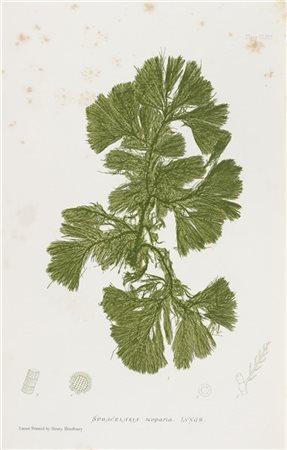 Il Ponte Casa d'Aste - Palazzo Crivelli - Via Pontaccio 12, 20121 Milano
Il Ponte Casa d'Aste - Palazzo Crivelli - Via Pontaccio 12, 20121 Milano
ASTA 500 : LIBRI E MANOSCRITTI II TORNATA : LIBRI E MANOSCRITTI
Tuesday 26 January 2021 hours 15:00 (UTC +01:00)
JOHNSTONE, William Grosart, and Alexander CROALL - The Nature-Printed British S
JOHNSTONE, William Grosart, and Alexander CROALL - The Nature-Printed British Sea-Weeds. Londra: Bradbury and Evans, 1859-60.
Buona copia in tela editoriale di quest'opera che usa il "nature printing" come tecnica illustrativa, ovvero un metodo per produrre una stampa di un oggetto naturale (come una foglia) facendone un'impronta direttamente su una lastra di metallo morbida sotto grande pressione e realizzando dunque un'impronta inchiostrata su carta. Si tratta del secondo libro pubblicato in Gran Bretagna con l'utilizzo della tecnica della "stampa naturale", dopo Ferns of Great Britain and Ireland (1855) di Thomas Moore, anch'esso illustrato da Bradbury. La fama di Bradbury quale inventore di questa tecnica fu contestata dallo stampatore imperiale austriaco Alois Auer che afferma invece che "certamente Bradbury portò il processo in Gran Bretagna e lì lo perfezionò" (ODNB).
4 volumi, 8vo (240 x 158mm). Occhielli, antiporte con vignetta con impressione dal naturale diversa in ogni volume, 221 tavole impresse dal naturale, una tavole con illustrazioni (un po' di fioriture più marcate al vol. I, pochi occasionali strappetti marginali). Tela editoriale verde stampata in oro e a secco. Provenienza: Albert R. Graves (exlibris). (4)
-EN
JOHNSTONE, William Grosart, and Alexander CROALL - The Nature-Printed British Sea-Weeds. London: Bradbury and Evans, 1859-60.
A good copy in editorial cloth of this work that uses "nature printing" as an illustrative technique, that is a method to produce a print of a natural object (such as a leaf) by making an imprint directly on a soft metal plate underneath using great pressure and thus creating an inked print on paper. This is the second book published in Great Britain using the "nature print" technique, after Thomas Moore's Ferns of Great Britain and Ireland (1855), also illustrated by Bradbury. Bradbury's fame as the inventor of this technique was disputed by the Austrian imperial printer Alois Auer who states instead that "certainly Bradbury took the process to Great Britain and perfected it there" (ODNB).
4 volumes, 8vo (240 x 158mm). Half-title, frontispiece with vignette with different natural impression in each volume, 221 plates printed from nature, one plate with illustrations (some more marked spots in vol. I, a few occasional marginal tears). Green editorial cloth printed in gold and blindstamped. Provenance: Albert R. Graves (bookplate). (4)





